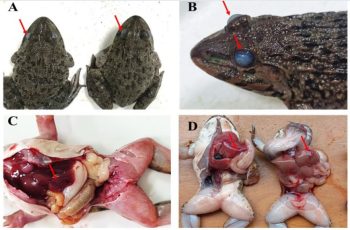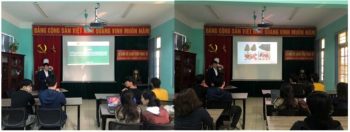The Faculty of Fisheries’ Aquatic Diseases Research & Development Group (ADRDG) hosted a symposium in the afternoon of December 19, 2022. Three presentations are included:
- Pham Thi Lam Hong, a member of the research team, presented her paper, “Effect of several conditions on the process of generating resting eggs of freshwater rotifers Brachionus calyflorus“
- Prof.Dr. Truong Dinh Hoai, a member of the research team, presented his research on “Isolation and antibiotic resistance of Streptoccocus agalactiae bacterium causing blindness in Thai frog (Rana tigerina) grown in various northern districts”.
The seminar was planned by Assoc. Prof. Dr. Kim Van Van, who also served as the session’s chair. Faculty members, researchers, and graduate students also attended.
Mr. Pham Thi Lam Hong discussed Brachionus calyciflorus during the seminar. It is a crucial part of the zooplankton in freshwater bodies and is a crucial source of fresh food for the development of aquatic breeds, including fish species with high economic value such as pangasius, catfish, and freshwater crayfish.

In this study, the researchers looked at how population density affected the production of resting eggs. They discovered that rotifers would suffer from excessive density and that resting eggs wouldn’t develop. For the concentration of NH3-N measured at a concentration of 2.5 mg/l, the rotifers stimulated resting eggs the most. Regarding the temperature issue, high temperatures are the ones that encourage rotifers to produce resting eggs the most (35oC). This discovery formed the basis for the development of a method for producing rotifer resting eggs, which made it possible to actively feed rotifers to freshwater aquaculture hatcheries, lessened the risk of disease transmission to larvae, and shortened the time needed for biomass culture.
In the following article, Associate Professor Dr. Truong Dinh Hoai talked about how Thai frogs grown in several northern districts are blinded by the S. agalactiae bacterium. 26 frog-raising families in the provinces of Hanoi, Ha Nam, and Thai Binh provided 83 frog samples suspected of having the blind eye illness, which has certain common symptoms such clouded eyes, blindness in one or both eyes (78, 3%), dark skin (53.0%), liver enlargement, and bleeding (69.9%). Gram (+) bacteria, streptococcus, are found in the liver, kidney, and spleen of sick frogs. These bacteria have spherical, convex, cream-colored colonies that are about 1mm in diameter. Based on morphological, biochemical, and PCR features, a total of 26 strains of S. agalactiae that cause illness in frogs have been successfully isolated and characterized. The lethal dosage of 50% (LD50) of three typical S. agalactiae strains (one strain per province) in juvenile frogs varied from 4.8 105 to 2.2 106 CFU/individual. The medications amoxicillin, florfenicol, and erythromycin showed a sensitivity rate of 65.4 – 80.8%, but the S. agalactiae bacteria isolated from sick frogs had a high resistance rate (61.5%) to oxytetracycline, sulfamethoxazole/trimethoprim.

During the debate, Assoc. Prof. Dr. Kim Van Van stated that the evaluation of the impact of various conditions on the resting egg production of freshwater rotifer B. calyflorus is a very important study for the production of wildlife seed in the Northern area of Vietnam. Vietnam. The use of freshwater rotifers as food during the initial feeding stage has reportedly enhanced the survival rate of pangasius to over 25%, which is in accordance with several study materials. But this thing hasn’t gotten the attention it deserves. S. agalactiae, which causes blindness in Thai frogs farmed in various northern provinces, is thought by many to be a prevalent illness that has cost frog growers a lot of money. But further study is required to determine the best way to treat this condition. Farmers must seek scholars’ opinions and recommendations in order to create production plans for hatcheries and aquaculture that are efficient and sustainable.



 Tiếng Việt
Tiếng Việt